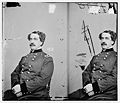Image Restoration/Getting started

Getting started
With image restoration, the first decisions are often the most important ones. It's important to select an image that has good potential and fits your skills.
Clarify goals
[edit | edit source]Some historic images have the potential to become featured pictures with a good restoration. Other times, because of limitations in the digital file or the scan the original image, a restoration can only go so far.
Here's an image of judge Learned Hand as a student:
-
A historic and useful image, but one that will never be a visual knockout. The photographer took the shot off center and cut off the building arch, and the file is low resolution.
-
After restoration: rotated and cropped, with ink marks removed and tears repaired. A small area of trouser leg at lower left was reconstructed. Levels adjusted.
Click on the thumbnails for the student portrait shows that the original version above was 922 × 682 pixel, file size: 136 KB, MIME type: image/jpeg. Compare that to the size below for a restoration that became a featured picture.
-
2,613 × 3,519 pixels, file size: 3.25 MB, MIME type: image/jpeg
-
2,613 × 3,519 pixels, file size: 3.52 MB, MIME type: image/jpeg
It may be a humbler subject--just a stonemason at work instead of law students at Harvard--but the photographic composition is pleasing and it serves as a good illustration of stonemasonry using traditional tools. The file size is also more than 20 times greater. Large files take more time to repair, but they also carry more information at high resolution.
One type of restoration isn't necessarily better than the other: both serve useful purposes. Be realistic about what your aims are, and about how much time and effort you intend to devote to a restoration. A skilled restorationist could do the student portrait in an hour, but the stonemason image would take a couple of days.
Be realistic about your skills
[edit | edit source]-
A good candidate for a beginning restorationist: moderate amounts of dust, dirt, and fiber to remove.
-
A tough challenge. Good quality scan and high resolution file, but a severely damaged portrait.
- Types of media
- File sizes
- Copyright
- Triage for image editing (easy-impossible-tough)
- Best practices
- Research
- Choosing a vision and following it
- Types of problems






